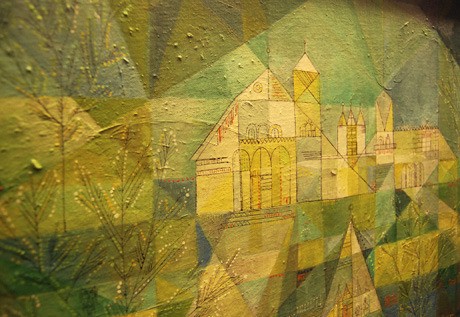Remembering and healing through Maria Abrams’ art at Aljoya
It’s hard to decide what is more remarkable; Maria Frank Abrams’ artwork or her life story. Both, of course, are connected.
A Hungarian-born Holocaust survivor, Abrams has spent the majority of her life in the Pacific Northwest. She studied art at the University of Washington after emigrating from war weary Europe in 1948. The young artist quickly fell in love with Washington’s landscape and “beautiful light.” It served as the inspiration for much of her work. And it helped the Holocaust survivor, who lost 33 members of her family — including her parents — to heal.
“In just a few months, I was responding to the landscape and this light. It was very consoling, like a healing process. In my work, I began creating things that were harmonious and peaceful. That was my desire — for life to be like that,” she told a Seattle Weekly journalist in 2002.
Today, the 86-year-old cannot speak for herself so eloquently. Having suffered two strokes, Abrams has reverted to speaking in mostly German, with broken English now and then. When her artwork was put on display at Aljoya House in February, Abrams’ husband, Syd, stood steadfastly by her side. The two have lived on Mercer Island since 1953 and, according to Syd Abrams, the Island has conversely found a home in his wife’s art.
“Many of her paintings were inspired by Luther Burbank, which she used to walk daily with one of her dogs,” he said.
The Island couple is proud to have a collection of Abrams’ paintings — mostly oil and casein — on Mercer Island, as are the residents of Aljoya House, who get to enjoy the vibrant canvases on a daily basis.
“I think her artwork is very evocative of what she feels as a Holocaust survivor now living in the Northwest — her colors and mountain peaks,” said resident Joanne Hockhberg, who knows the artist personally.
Indeed, Abrams’ work is infused with emotion. The colors speak for themselves: vibrant blues, streaks of orange and torrents of red. Her subjects vary: A tranquil, domestic self-portrait. An abstract painting of dancing lines. A birch forest illuminated by sunset. All the paintings seem to speak from her soul.
Abrams has received much attention over the years. In fact, a book on her life and work, “Maria Frank Abrams: Burning Forest” (Museum of Northwest Art), will be published later this month. Local art critic Matthew Kangas is the author.
In her past, Abrams has been a set designer for the 1962 opera “The Dybbuk” and Seattle Opera’s 1963 production of “La Traviata.” Her work is in the collection of the Seattle Art Museum; the Wadsworth Atheneum, in Hartford, Conn.; and the Art Museum of Yad Vashem, Jerusalem, among others. Now it is on Mercer Island.
With Holocaust Remembrance Day this Sunday, April 11, there’s no better way to pay respect than to view the work of a woman who survived. Not only did Abrams survive, but she flourished.
Maria Frank Abrams’ work is in the Aljoya House gallery, on the second floor. Aljoya House is located at 2430 76th Ave. S.E. in the Town Center. Her artwork will be displayed through April.



